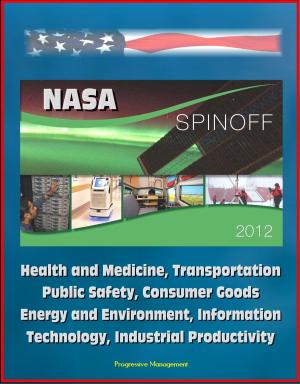Prophecy Fulfilled: "Toward New Horizons" and Its Legacy, Seminal Reports on Air Power Technology and Military Aeronautics: Where We Stand, Science the Key to Air Supremacy, Dr. Theodore von Karman
Nonfiction, Science & Nature, Technology, Aeronautics & Astronautics, History, Military, Aviation| Author: | Progressive Management | ISBN: | 9781310209840 |
| Publisher: | Progressive Management | Publication: | August 6, 2015 |
| Imprint: | Smashwords Edition | Language: | English |
| Author: | Progressive Management |
| ISBN: | 9781310209840 |
| Publisher: | Progressive Management |
| Publication: | August 6, 2015 |
| Imprint: | Smashwords Edition |
| Language: | English |
Professionally converted for accurate flowing-text e-book format reproduction, this Air Force publication presents several historic air power technology and military aeronautics: Where We Stand was written in 1945 and issued as an AAF Report in 1946. Science, the Key to Air Supremacy, originally published in 1945 as part of the multi-volume Toward New Horizons, was reprinted by the Air Force Systems Command History Office in 1992.
Since the days of ancient warfare, commanders have relied on science and technology for success in war. Their use in military affairs increased dramatically after the Scientific and Industrial Revolutions, particularly in the nineteenth century. For example, chemists and metallurgists contributed greatly to World War I, while World War II is sometimes referred to as the physicists' war. During the fifty-year conflict known as the Cold War, scientists from diverse disciplines collaborated to multiply the effectiveness of military force and meet national security needs.
Of all the federal organizations devoted to science and technology, none has been more important or influential than the U.S. Air Force's Scientific Advisory Board. In the midst of World War II the Commanding General of the Army Air Forces, Henry H. "Hap" Arnold grasped the absolutely essential relationship between post-war science and national security. To realize his objective of inextricably linking science to air power, he called upon his friend, the brilliant Hungarian physicist Theodore von Karman, to assess and predict the future of military aeronautics. In Where We Stand and in Science, the Key to Air Supremacy, Karman and his hand-picked staff devised a multi-disciplinary approach to preserving the technical advantage gained by U.S. air power during the war. Both of these seminal reports are herein reprinted.
Although the Cold War has ended and the imperatives of national security have changed radically, the basic technological conditions which informed both Arnold and Karman remain the same. Now as then, the capacity exists for sudden and devastating attack on the American continent. Now as then, a large commitment must be made to research which renders the skies safe from aggressors and enables the national command structure to project air power at great distances. Now as then, the boldness and imagination of the nation's scientists and engineers must be harnessed to defend American security. The history of the Scientific Advisory Board's first half century offers the encouragement and example that such needs can be met and that the future of democracy can be secured in large measure by the mobilization of American science and technology in service to the global air and space power of the United States Air Force.
Professionally converted for accurate flowing-text e-book format reproduction, this Air Force publication presents several historic air power technology and military aeronautics: Where We Stand was written in 1945 and issued as an AAF Report in 1946. Science, the Key to Air Supremacy, originally published in 1945 as part of the multi-volume Toward New Horizons, was reprinted by the Air Force Systems Command History Office in 1992.
Since the days of ancient warfare, commanders have relied on science and technology for success in war. Their use in military affairs increased dramatically after the Scientific and Industrial Revolutions, particularly in the nineteenth century. For example, chemists and metallurgists contributed greatly to World War I, while World War II is sometimes referred to as the physicists' war. During the fifty-year conflict known as the Cold War, scientists from diverse disciplines collaborated to multiply the effectiveness of military force and meet national security needs.
Of all the federal organizations devoted to science and technology, none has been more important or influential than the U.S. Air Force's Scientific Advisory Board. In the midst of World War II the Commanding General of the Army Air Forces, Henry H. "Hap" Arnold grasped the absolutely essential relationship between post-war science and national security. To realize his objective of inextricably linking science to air power, he called upon his friend, the brilliant Hungarian physicist Theodore von Karman, to assess and predict the future of military aeronautics. In Where We Stand and in Science, the Key to Air Supremacy, Karman and his hand-picked staff devised a multi-disciplinary approach to preserving the technical advantage gained by U.S. air power during the war. Both of these seminal reports are herein reprinted.
Although the Cold War has ended and the imperatives of national security have changed radically, the basic technological conditions which informed both Arnold and Karman remain the same. Now as then, the capacity exists for sudden and devastating attack on the American continent. Now as then, a large commitment must be made to research which renders the skies safe from aggressors and enables the national command structure to project air power at great distances. Now as then, the boldness and imagination of the nation's scientists and engineers must be harnessed to defend American security. The history of the Scientific Advisory Board's first half century offers the encouragement and example that such needs can be met and that the future of democracy can be secured in large measure by the mobilization of American science and technology in service to the global air and space power of the United States Air Force.















